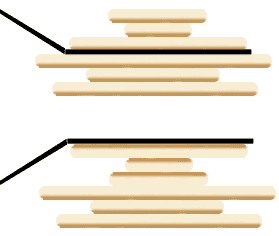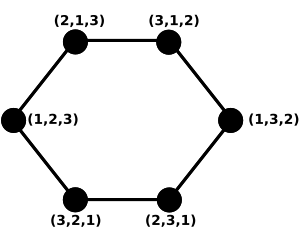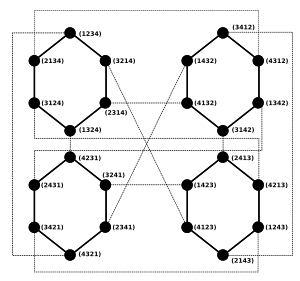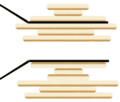Pancake sorting facts for kids
Pancake sorting is a fun math problem about organizing a stack of pancakes. Imagine you have a pile of pancakes, all different sizes, mixed up. Your goal is to sort them from smallest to largest, with the smallest on top. The only tool you can use is a spatula. You can slide the spatula into any part of the stack and flip over all the pancakes above it.
The challenge is to find the fewest number of flips needed to sort the stack. This minimum number of flips is called the pancake number. This problem was first talked about by an American mathematician named Jacob E. Goodman. There's also a trickier version called the burnt pancake problem, where each pancake has a burnt side, and they all need to end up with the burnt side facing down.
Unlike many other sorting methods that focus on comparing items, pancake sorting is all about minimizing the actual flips or operations. You're not counting how many times you compare pancakes, but how many times you use the spatula!
Contents
Understanding Pancake Problems
The Original Pancake Challenge
Finding the exact fewest flips needed to sort any stack of n pancakes is a tough math problem. Scientists know the answer is somewhere between about 1.07 times the number of pancakes and 1.64 times the number of pancakes. But the exact number is still a mystery!
One simple way to sort pancakes takes at most `2n - 3` flips. Think of it like this:
- First, you find the largest unsorted pancake.
- You flip the stack so that this largest pancake is at the very top.
- Then, you flip the stack again to move that largest pancake to its correct spot at the bottom.
- You repeat these steps for the remaining pancakes.
In 1979, Bill Gates (yes, the founder of Microsoft!) and Christos Papadimitriou worked on this problem. They figured out that you need at least 1.06 times the number of pancakes in flips. They also found an upper limit for the number of flips. Thirty years later, a team at the University of Texas at Dallas improved this upper limit.
In 2011, some researchers proved that finding the absolute shortest way to sort a given stack of pancakes is a really hard problem for computers to solve quickly. It's called an NP-hard problem.
The Burnt Pancake Puzzle
The burnt pancake problem is a twist on the original. Imagine each pancake has one side that's burnt. When you're done sorting, every pancake must have its burnt side facing down. This adds an extra layer of difficulty because you also have to worry about the direction of each pancake.
In 2008, some college students even used a special kind of bacterial computer to solve a simple version of the burnt pancake problem! They programmed tiny bacteria called E. coli to flip pieces of DNA, which acted like burnt pancakes. When the bacteria solved the problem, they became resistant to antibiotics, letting the students know they succeeded.
Sorting Identical Pancakes
This problem is inspired by how Indian bread, like roti or chapati, is cooked. Imagine you have a stack of identical rotis. The cook uses a spatula to flip them so that each side touches the hot pan to get toasted. The challenge is to toast all sides of all rotis with the fewest flips. There are different versions of this problem, depending on whether the rotis are one-sided or two-sided, and if you're allowed to toast the same side twice.
Pancake Sorting for Strings
So far, we've talked about pancakes that are all unique, like different sizes. But what if the "pancakes" aren't unique? Imagine you have a sequence of letters or numbers where some are repeated. This is called a "string" in computer science. Sorting these strings with prefix reversals (like pancake flips) can be different.
Scientists have shown that finding the shortest way to sort these strings is also a very difficult problem for computers. They have found ways to estimate the number of flips needed and even exact methods for sorting strings made of only two or three different symbols.
History of Pancake Sorting
The pancake sorting problem was first thought up by Jacob E. Goodman. He used the funny pen name "Harry Dweighter," which sounds like "harried waiter."
Even though it seems like a fun puzzle, pancake sorting is actually useful! It helps in designing networks for parallel computers. These are computers that do many tasks at the same time. Pancake sorting can help figure out the best way for different parts of the computer to send information to each other.
The problem is famous because it's the topic of the only well-known math paper written by Microsoft founder Bill Gates. He co-wrote it in 1979, and it described an efficient way to sort pancakes. Also, David X. Cohen, who helped create the TV show Futurama, wrote an important paper about the burnt pancake problem.
Pancake Graphs
A n-pancake graph is a special kind of map that shows all the possible ways to arrange n pancakes and how you can get from one arrangement to another with a single flip.
- Each circle (called a "vertex") in the graph represents a unique way to stack the pancakes.
- Each line (called an "edge") connects two stacks that can be changed into each other with just one flip.
For n pancakes, there are n! (n factorial) different ways to stack them. The "diameter" of a pancake graph tells you the longest shortest path between any two stacks. This is basically the maximum number of flips needed to sort any stack of n pancakes.
Pancake graphs are very interesting to computer scientists. They are used to design how different parts of parallel computers connect and talk to each other. Because these graphs have special properties, they can help make computer networks that are very efficient and fast.
Images for kids
See also
 In Spanish: Ordenamiento de panqueques para niños
In Spanish: Ordenamiento de panqueques para niños







